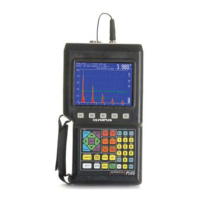Managing the Datalogger and Data Communication Features
Part # 910-250C
71
8 Managing the Datalogger and Data
Communication Features
This chapter describes how to manage the EPOCH 4PLUS datalogger. Olympus NDT
TM
has designed the datalogger for ease of use while providing a wide range of features for
virtually all flaw detection and thickness gaging requirements. It includes the following
capabilities:
• Data organized by file and identifier (ID) code
• Alphanumeric file names and identifier codes
• Memo mode to allow entry of detailed comments
• Edit feature for adding, deleting, and clearing of individual file names and IDs
• On-screen scroll/review of all file contents
• Quick recall of stored setups
• Ability to transfer data between the unit and a PC or printer
Topics are as follows:
• Defining the Datalogger Storage Capacity
• Using the Memory Screen
• Using the Alphanumeric Keypad
• Creating New Files and Identifier (ID) Codes
• Saving Waveforms and Thickness Readings
• Incrementing ID Codes
• Recalling Transducer Calibrations and Waveforms
• Saving and Recalling Quick Recall Calibrations
• Creating Memos
• Editing a File
• Printing
8.1 Defining the Datalogger Storage Capacity
The EPOCH 4PLUS datalogger is designed to store the following data:
• Thickness Reading
- Identifier (ID) code
- Alarm conditions
- Peak/Edge Depth Mode Indicator

